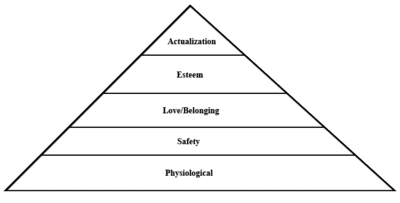Maslow's hierarchy of needs is a theory in psychology that Abraham Maslow proposed in his 1943 paper A Theory of Human Motivation, which he subsequently extended. His theory contends that as humans meet their basic needs, they seek to satisfy successively higher needs that occupy a set hierarchy.
Pyramid of needs

Maslow's hierarchy of needs is often depicted as a pyramid consisting of five levels: the four lower levels are grouped together as deficiency needs, while the top level is termed being needs. While our deficiency needs must be met, our being needs are continually shaping our behaviour. The basic concept is that the higher needs in this hierarchy only come into focus once all the needs that are lower down in the pyramid are mainly or entirely satisfied. Growth forces create upward movement in the hierarchy, whereas regressive forces push prepotent needs further down the hierarchy.
Deficiency needs
The deficiency needs (also termed D-needs by Maslow) are:
Physiological needs
Safety needs
When the physiological needs are met, the need for safety will emerge.
Safety or security ranks above all other desires; a properly-functioning
society tends to provide security to its members. Recent examples of failure
in this area include the cases of societal breakdown in Somalia and Afghanistan.
Sometimes the desire for safety outweighs the requirement to satisfy physiological
needs; for example, during the Kosovo War many residents of Kosovo chose
to occupy a secure area rather than an insecure area, even though the
latter provided better access to food.
Love/Belonging needs
Once a person's physiological and safety needs are largely met, the third
layer of human needs starts to become apparent. This involves emotionally-based
relationships in general, which includes the perceived need for companionship
(both sexual and non-sexual) and/or having a family. There is the sense
of community or affiliation; in other words, humans want to belong to
groups, whether it be clubs, work groups, religious groups, family, gangs,
etc. They need to feel loved (sexually and non-sexually) by others, and
to be accepted by them. People also need to feel needed. In the absence
of these elements, people become increasingly susceptible to loneliness
and social anxieties.
Esteem needs
There are two versions of esteem needs - the need for the respect of and
recognition by others, and the need for self-respect.
Being needs
Though the deficiency needs may be seen as "basic", and can
be met and neutralised (i.e. they stop being motivators in one's life),
self-actualization and transcendence are "being" or "growth
needs" (also termed "B-needs"), i.e. they are enduring
motivations or drivers of behaviour.
Self-actualization
Self-actualization (a term originated by Kurt Goldstein) is the instinctual
need of a human to make the most of their unique abilities. Maslow described
it as follows:
A musician must make music, the artist must paint, a poet must write,
if he is to be ultimately at peace with himself. What a man can be, he
must be. This need we may call self-actualisation. (Motivation and Personality,
1954.)
Maslow writes of self-actualizing people that:
1. They embrace the facts and realities of the world (including themselves)
rather than denying or avoiding them.
2. They are spontaneous in their ideas and actions.
3. They are creative.
4. They are interested in solving problems; this often includes the problems
of others. Solving these problems is often a key focus in their lives.
5. They feel a closeness to other people, and generally appreciate life.
6. They have a system of morality that is fully internalized and independent
of external authority.
7. They judge others without prejudice, in a way that can be termed objective.
Self-transcendence
Although Maslow tentatively placed transcendence at the top of his hierarchy,
this element has been discounted by most modern psychologists because
they feel it really belongs in the domain of religious belief.
Critiques
While Maslow's theory may be regarded as an improvement over previous
theories of personality and motivation, concepts like self-actualization
are vague. This becomes problematic to operationalize and test Maslow's
theory. There is no proof that every individual has the capacity for self-actualization.
Additionally, in their extensive review of research that is dependent
on Maslow's theory, Wabha and Bridwell (1976) found little evidence for
the ranking of needs that Maslow described, or even for the existence
of a definite hierarchy at all. (It should be noted that Maslow himself
documented and explored various paradoxes and subtleties in relation to
his theory.)
Some people feel that the theory and its concepts have been overused. For instance, references to the theory occur in many undergraduate organizational behavior textbooks without any explication of the subtleties of the theory or any acknowledgement of its possible flaws. The word self-actualization is sometimes regarded as psycho-babble.
Additionally, it has been suggested that not everyone ultimately seeks the self-actualization that a strict (and possibly naive) reading of Maslow's hierarchy of needs appears to imply:
1. Viktor Frankl's book Man's Search for Meaning describes his psychotherapeutic
method (logotherapy) of finding purpose in life.
2 Albert Einstein was actually drawn toward the sense of mystery in life.
See Abraham Pais' Subtle is the Lord.
3. Others seek to perform good works, like Mother Teresa.
4. Others are drawn toward the dark side of the human condition.
However, these individuals would not be mentioned in history books if they had not used their inherent writing, therapeutic or altruistic gifts differently from most other people.




